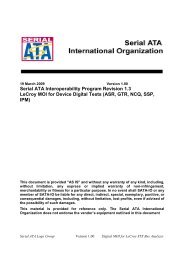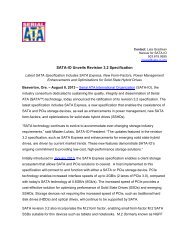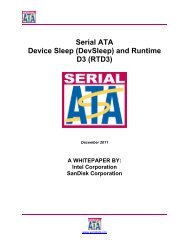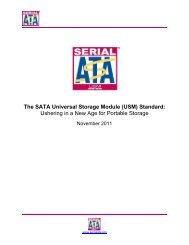1.0 - SATA-IO
1.0 - SATA-IO
1.0 - SATA-IO
- No tags were found...
You also want an ePaper? Increase the reach of your titles
YUMPU automatically turns print PDFs into web optimized ePapers that Google loves.
Tektronix, Inc.Appendix B – TDR Alignment and Acquisition SetupIntroductionThis deskew procedure utilizes an independent acquisition source and assumes availability of two TDR samplingmodules (80E04, 80E08, or 80E10). It can also be used with one TDR (80E04, 80E08, or 80E10), and one dualsampling module (80E03 or 80E09). It aligns both samplers and TDR steps allowing measuring mixed mode S-parameters. The procedure starts with the alignment of the samplers and concludes with alignment of the acquisitionchannels.Match samplers to the ends of the cablesThe purpose of this step is to set the samplers on each channel so that an input into the open end of each cablearrives at the sample gate at precisely the same time. This step compensates for cable and sampler differences. Firststage is alignment of the channels 1-3 using the channel 4 as an independent TDR source, and then aligningacquisition of the channel 4 with respect to already aligned channel 3 using channel one as another independentsource. 2 The deskew procedure is to be performed in rho mode.1. Connect SMA cables to the sampling modules of the oscilloscope. For the best results, it is desired that theSMA cables used in the measurements have approximately the same quality and length (matched within 20ps).2. Connect channel 1 and channel 4 with SMA barrel, activate TDR step on channel 4 and acquisition on channel1 (see Figure 2).Figure 2 C1 is connected to C4 with SMA barrel. The TDR step is generated on C4 and acquiredusing C1.3. Adjust the horizontal position and scale to get the rising edge on screen with good resolution (20ps/div). Recordlength should have the maximum number of 4000 points.4. Save channel one (C1) waveform as a reference trace. Channel 2 and 3 will be aligned with respect to it.5. Connect channel two (C2) to the channel four (C4) using SMA barrel, and display C2 on the screen.6. Turn on the delay measurement to measure the time difference between the rising edge on the reference traceand the rising edge of C2 as shown in Figure 3.2 When only one TDR and one sampling modules are available another TDR channel can be used as an independentTDR source.<strong>SATA</strong> Rx/Tx MOI Revision 1.1 ver <strong>1.0</strong>45













